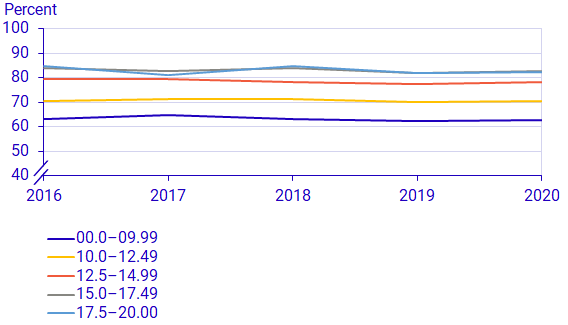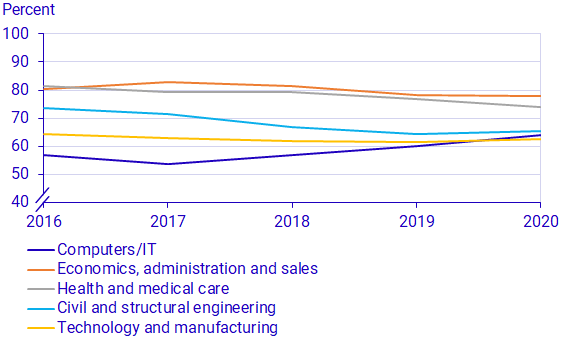Graduation rate in higher vocational education, 2016–2020
Students with high upper secondary school grades are more likely to graduate from higher vocational education
Statistical news from Statistics Sweden 2022-03-15 8.00
At the same time, students’ prior educational attainment level matters less for the probability of graduating. The graduation rate varies greatly between fields of education and among the larger fields there is a lower probability of graduating in the fields Computers/IT and Technology and manufacturing.
Higher vocational education is a post-secondary form of education that is essential for skills supply in Sweden, and which has therefore been expanded in recent years. However, far from everyone who starts a programme graduates from it. Using a statistical analysis model, we show which groups of students have a higher or lower probability of graduating. The statistics are based on the graduation rate in 2016 to 2020.
The total graduation rate was 71.6 percent in 2020. The graduation rate of women was 75.8 compared with 66.1 for men. This difference between the sexes has however narrowed in the past few years.
The higher the grades from upper secondary school, the greater the probability of graduating
For the analysis, the upper secondary school grades have been divided into groups. The probability of graduating increases with each group of grades. The greatest difference is between those with the lowest grades and those with the highest. The differences then gradually decline. However, the probability does not differ between those with grades between 15.0 and 17.49, and those in the highest group of grades.

At the same time, students’ prior educational attainment level matters less. Although the differences are small, it is more probable that a student with upper secondary education will graduate than one who has studied in higher education previously. The parents’ educational attainment level has a negligible impact on the probability of graduating.
Lowest probability of graduating from Computers/IT programmes
The analysis model shows that students in Computers /IT programmes have a lower probability of graduating than those within most other fields. The graduation rate for students within Computers /IT has also been among the lowest, but has increased in the past few years, among both women and men. In 2020, the graduation rate was slightly higher for Computers /IT than for Technology and manufacturing.
Students within Technology and manufacturing have a greater probability of graduating than those within Computers /IT. However, the probability is lower for Technology and manufacturing than for students within the three other major fields of education.
Previous studies show that factors related to the programme, such as its quality, are of great significance to the graduation rate.

Several factors of significance to the graduation rate
According to the statistical analysis model, the following factors are also linked to the probability of graduating:
- If the proportion of distance learning programmes increases and everything else is unchanged, the graduation rate will decrease – at least according to the relationship shown by the model.
- The probability of graduating is higher for women than for men.
- Students enrolled in programmes that have many eligible applicants per place have a greater probability of graduating.
- The probability of graduating is higher for people born in Sweden than those born abroad.
- According to the statistical model, the probability of graduating is higher for people who have worked prior to attending a higher vocational education programme than for those who have not.
The following factors are less significant to the probability of graduating:
- parents’ educational attainment level
- the age of the student
- the type of upper secondary programme attended by the student
- programme length
- study rate.
Definitions and explanations
Official statistics on higher vocational education
Since 2018, Statistics Sweden has been responsible for official statistics on higher vocational education. Statistics on graduates of higher vocational education are based on information from the Swedish National Agency for Higher Vocational Education which, in turn, receives the information from the education providers.
Post-secondary vocational education is included in the statistics for 2007–2013.
Graduates
‘Graduates’ refers to everyone who graduated from a programme session. Graduates are reported based on the final year of the programme, and not based on the date on which the student actually graduated. Late additions cause some lag in the statistics, and it is estimated that around 100 graduates will be added in the next publication in November 2022.
Graduation rate
The graduation rate as a percentage refers to the proportion of admitted students who have studied in programmes that lead to a qualification. Late additions affect the graduation rate.
Field of education
Field of education refers to the classification of programmes into the fields of education used by the Swedish National Agency for Higher Vocational Education. The fields of education are based on the SUN 2020 standard.
Upper secondary school grades
Upper secondary school grades have been converted into grade points as follows:
- Grades until 2012/13 (Lpf 94): IG=0, G=10, VG=15 and MVG=20
- Grades as of 2013/14: F=0, E=10, D=12,5 C=15, B=17,5 and A=20.
The statistical analysis model
Studying how the graduation rate varies between different types of programmes or different groups of students provides valuable knowledge. It enables seeing for instance that, on average, women have a higher graduation rate than men and that people with higher upper secondary school grades have a higher graduation rate on average than those with lower grades. There is however a risk of drawing erroneous conclusions if we use these descriptive statistics alone. It could be the case that women and men differ a great deal in the grades they obtain from upper secondary school, and that sex does not matter, but grades do. To study this, we use an analysis model in which we can compare the graduation rate for students who have attended similar programmes and who have similar characteristics. This is also called studying the impact of a variable on the graduation rate given that all other variables in the model are held constant.
The method used for the analysis is called multiple logistic regression analysis. The purpose of the analysis model is to identify which variables, according to the statistical model, have a relationship with the graduation rate. Part of the analysis is to study how the variables covary with each other and how certain we can be that the variables actually matter.
Publication
Next publishing will be
Statistics on students in 2021 will be published on 24 March 2022. Statistics on graduates in 2021 will be published in November 2022. Both will be published on www.scb.se/UF0701.
Statistics on employment and income after completed education will be published on 30 March 2022. The statistics will be published on www.scb.se/UF0503.
Feel free to use the facts from this statistical news but remember to state Source: Statistics Sweden.
